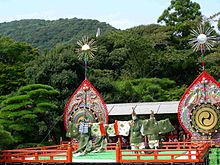|
Kannamesai Festival

The festival is the culmination of a cycle of festivals that take place throughout the year, beginning in April with the Shinden Geshusai (神田下種祭) which sees the sowing of the rice seeds. This is followed by Otaue Hajime (御田植初) where seedlings are transplanted in May, harvest at the Nuibosai (抜穂祭) in September, and finally, the Kannamesai.[1] OverviewKannamesai is one of the three seasonal festivals held throughout year.[1] The festival is held before the Niinamesai at the Imperial Palace and follows the lunar calendar, taking place in the ninth lunar month and includes an imperial envoy carrying offerings of silk and other gifts.[1] Rituals and CeremoniesThe festival begins on the evening of October 15 with the Okitama-no-kami-sai (興玉神祭) in which a guardian kami of the shrine, Okitama, is invoked. This is followed by the Miura (御卜), a divination ritual to determine if any of the clergy participating in the festival are impure, rendering them unfit to participate. The clergy then present [yuki-no-о̄mike] Error: {{nihongo}}: transliteration text not Latin script (pos 9) (help) (由貴大御饌), edible offerings in the form of fish, vegetables, water, and sake, followed by the presenting of heihaku offerings by an imperial envoy, and the rituals are completed with a kagura dance. These rituals are largely repeated twice for each of the Inner and Outer Shrines, once in the evening and once the following morning.[4] During the festival, the Emperor performs distance worship (御遙拝, [goyо̄hai] Error: {{nihongo}}: transliteration text not Latin script (pos 4) (help)) at the Shinkaden (神嘉殿), a hall in the Imperial Palace.[5] HistoryThe festival may have its roots in the legend from Emperor Suinin's time in which Princess Yamatohime-no-mikoto looked for a place to enshrine the Imperial Family's ancestral spirits during which she made an offering of rice stalks in the beak of a white-naped crane.[1] This became a true festival in 721 when Empress Genshō sent offerings called reihei (例幣) to Ise Shrine in the ninth month of the lunar calendar.[6] The practice stopped in the Middle Ages but restarted during the Edo period.[3] After Japan adopted the Gregorian calendar in 1873, the ninth month no longer aligned with the harvest season of rice, and the Kannamesai was moved to October in 1879 to compensate.[1] NotesReferences
|